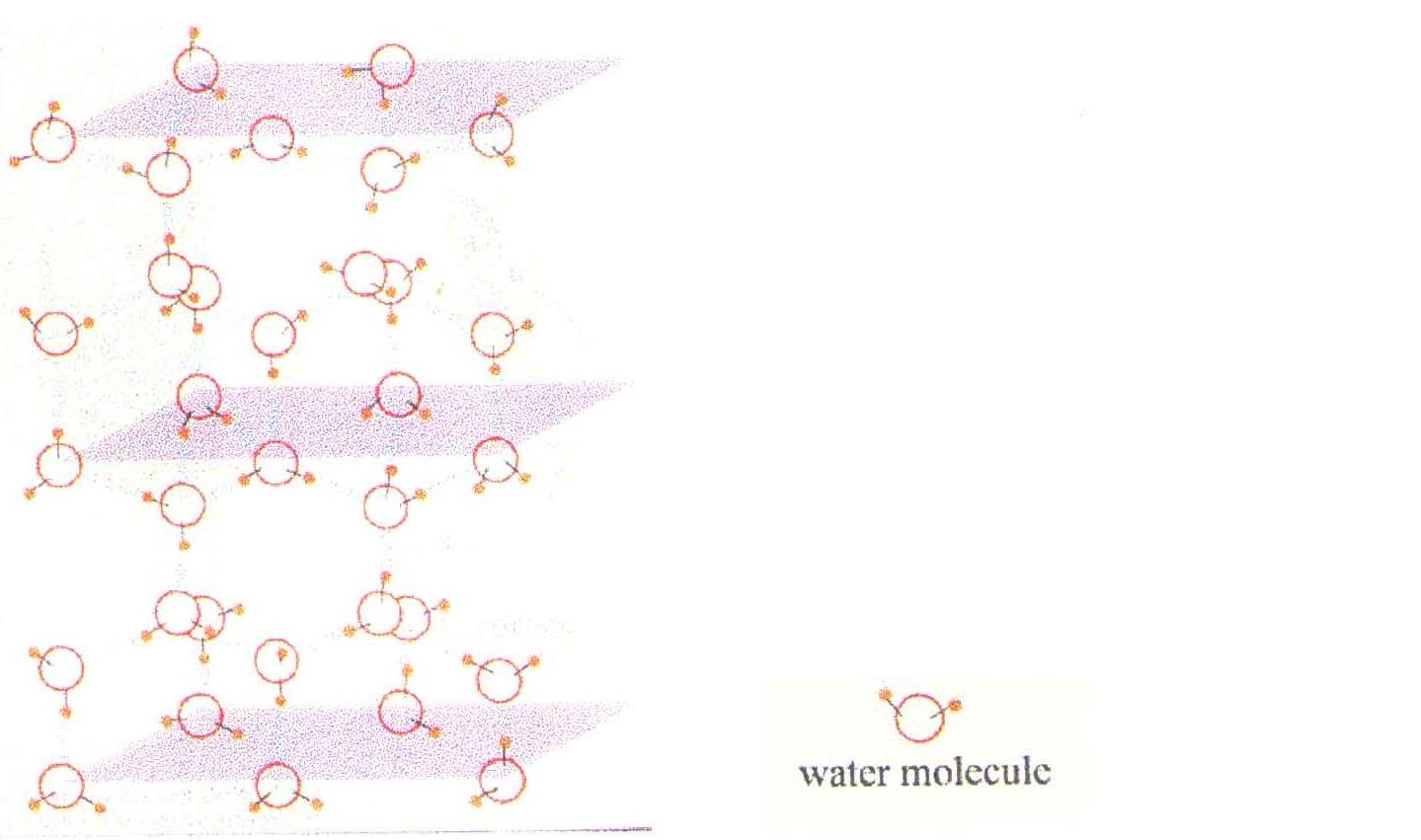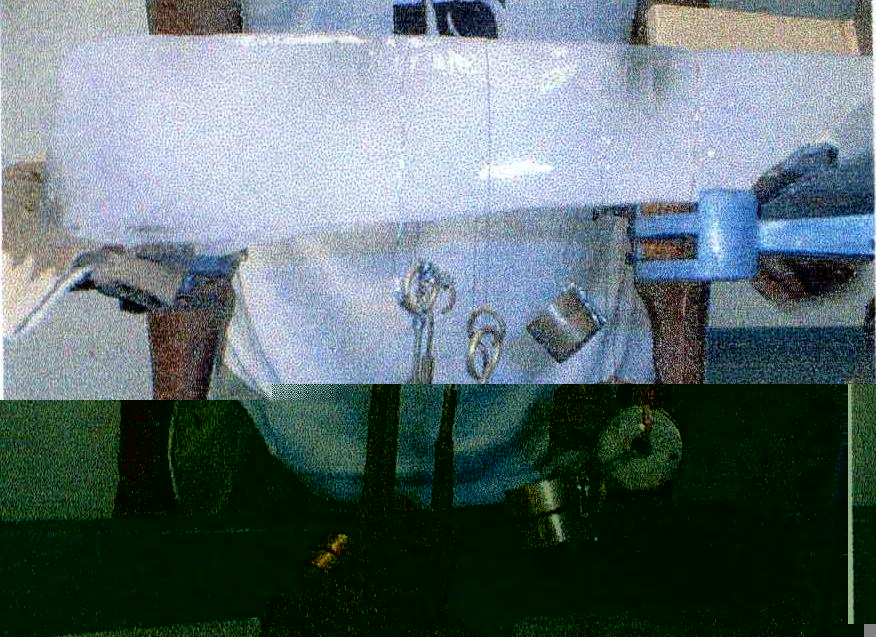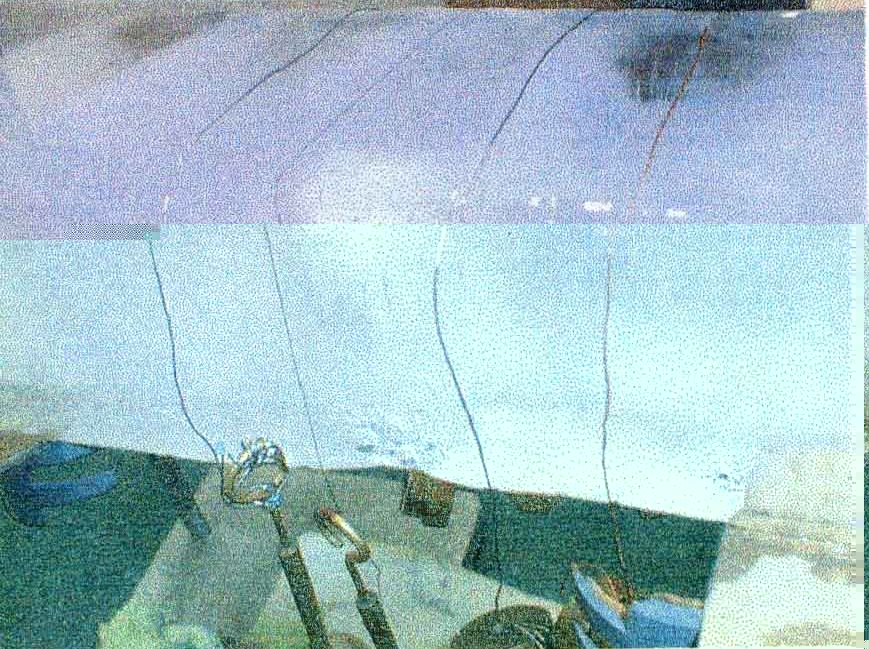

INTRODUCTION
Melting of 3-dimensional solids usually starts at the free surface, which typically melts at a lower temperature than the bulk material. Pressure is commonly believed to be the main factor, which determines the degree of surface melting. This, however, is an oversimplification of the actual process involved. Through a simple but insightful calculation, it will be shown that the pressure required for any significant surface melting is too large to be just provided by the application of foreign bodies on the surface. From our investigation, it seems to indicate that the degree of surface melting depends chiefly on the properties of material acting upon the surface. Possible counter action by the strong dipole moments of water molecules resulting in disorientation of surface molecules due to the introduction of foreign bodies will also be discussed.
Current theory
The controversy of the reasons behind oneís ability to skate on ice is clouding the field of surface science for years. In many secondary level Physics textbooks, pressure is noted to be the main factor for the explanation of oneís ability to skate. Moreover, many scientist generally believe that a skaterís blade exerts a significant pressure that reduces the melting point of the ice in contact. This results in the melting of the surface layer, subsequently producing a thin film of water, which reduces friction and enabling the skater to glide gracefully. In reality, the pressure exerted by the skaterís weight on the skating blades only reduces the melting point negligibly. To prove this, the Clausius-Clapeyron equation is applied to determine the rate of decrease of the melting point of ice with the increase in pressure at 273.15K:

Where Lm: Specific Latent Heat of fusion
Vm: Change in volume per unit mass of ice during solid-liquid phase transition
We will make use of the following data in our calculations:
 1
1
 2
2
L, specific latent heat of ice=3.34 x 105 J kg-1
![]()


![]()
This implies that to reduce the melting point of ice by 1K, a pressure of about 140 atm is required. We make the following assumptions to determine the magnitude of pressure exerted by a typical skater:
Surface area of skating blade = 0.0004 m2
Mass of skater =80 kg
Pressure exerted by skater 
With this pressure, the reduction in melting of ice is only 0.14K that is hardly substantial. Furthermore, it is interesting to note that ice-skating can be achieved even at sub-zero temperatures. Therefore, pressure cannot be the only explanation and it can be concluded that there exist some other factors, which could induce surface melting.
PROPOSED THEORY
From our readings of some surface activities at the molecular level may provide a better explanation of this process. At the molecular level, the surface ice molecules exist with a smaller coordination number relative to the bulk molecules. This can be seen from the following diagram.
 |
The circumstance would greatly alter the properties of that of the surface molecules. Thus, it would be appropriate to infer that surface molecules possess lower electrostatic potential energy in terms of magnitude and hence are less tightly bound as compared with the bulk molecules. Henceforth, the melting point of the former are expected to be lower than that of the latter. This generally accounts for the melting of surface before the bulk to form the thin water film on the ice. |
Surface polarising field
The unpaired electrons of oxygen atoms and positively charged hydrogen atoms set up a polarising field across the surface. The polarising field, however, does not vanish as in the bulk, but rather exist to participate in the reaction with a surfactant of polar nature.
For the case of skating, the metal blade acts as a polar surfactant on the ice surface. The metal blade is considered a polar surfactant by virtue of the arrangement of the metal nuclei and their free electrons, which at any instant, can set up a temporary charge on the metal surface. The instantaneous charged surface would establish a field of attraction to the ice surface. Depending on the magnitude of the charge, the surface molecules of ice would experience different extent of disordering as like poles attract and unlike poles repel. Generally, the greater the charge, the larger the extent of disordering. This disordering may eventually lead to the weakening of intermolecular bonds and thus lead to a phase transition of the surface molecules.
EXPERIMENTAL RESULTS
Experiment 1
| Objective : | To show that pressure is not the main factor causing surface melting of ice and that other aspects have to be taken into account. |
| Apparatus : | Retort stand, weights, ice block, copper wire, constantan wire, nylon string, cotton string, rubber string, stop watch. |
Procedure :
Recordings:
|
Materials |
copper |
nichrome |
constantan |
nylon |
cotton |
|
Average diameter / mm |
0.56 |
0.58 |
0.58 |
0.13 |
0.15 |
|
Material |
*Area, A/ 10-5 m2 |
**Mass, M/ kg |
***Pressure, P/ 105 Nm2 |
|
Copper |
6.44 |
0.200 |
0.304 |
|
Nichrome |
6.67 |
0.200 |
0.294 |
|
Constantan |
6.67 |
0.200 |
0.294 |
|
Nylon |
1.50 |
0.200 |
1.31 |
|
Cotton |
1.73 |
0.200 |
1.13 |
|
Materials |
# Average depth of ice cut, d1/cm |
|
copper |
0.83 |
|
nichrome |
0.79 |
|
constantan |
0.75 |
Note: cotton and nylon did not cut at all.
#
after 1 hour
Conclusion
Based on the results of this experiment, we can conclude that pressure is not the main factor causing surface melting because the rate of cutting of ice varies for different materials. It can be seen that although nylon and cotton exert higher pressures than the rest, they only cut through negligibly. Conversely, the three wires cut through the most, with copper showing the greatest depth.
Experiment 2
| Objective : | To conduct the experiment at a lower temperature to determine the effect of temperature on surface melting. |
| Apparatus : | 2 identical blocks of wood, a block of ice, a copper wire, nylon string, constantan, nickel and cotton string. |
Procedure
Recordings:
|
Materials |
copper |
nickel |
constantan |
nylon |
cotton |
rubber |
|
Average Diameter/ mm |
0.15 |
0.28 |
0.60 |
0.14 |
0.13 |
0.34 |
|
Material |
*Area, A/ 10-5m2 |
**Mass, m/ kg |
***pressure, P/ 105Pa |
|
Copper |
5.10 |
0.00 |
0.384 |
|
Nickel |
2.83 |
0.100 |
0.347 |
|
Constantan |
6.06 |
0.200 |
0.323 |
|
Nylon |
1.41 |
0.050 |
0.348 |
|
Cotton |
1.31 |
0.050 |
0.374 |
|
Rubber |
3.43 |
0.100 |
0.286 |
Recordings :
|
Materials |
# Average depth of ice cut, d1/cm |
|
copper |
0.65 |
|
nickel |
0.58 |
|
constantan |
0.58 |
note: nylon, cotton and rubber did not cut.
#
after 1 hourObservations
Since all 5 wires are placed simultaneously on the same ice block and allowed to cut through, we can assume that the pressure exerted on each contact area is almost the same and this should cause the rate of cutting of ice by the 5 different materials to be the same if the pressure is the main factor involved in the surface melting of ice. However, this is not true. From the readings, we can conclude that pressure only plays a minor role compared to the type of material being used, in particular the thermal conductivity and the specific heat capacity of the material.
Conclusion
From the results, we can observe that copper cuts the fastest while the cotton and nylon strings did not even cut at all. When this result is compared to the established specific heat capacity of the 5 different materials, it is inferred that materials with low specific heat capacity or high thermal conductivity tend to cut faster than materials with higher specific heat capacity. This is shown in the table of the materials and their relative specific heat capacities and thermal conductivity below.
|
Materials |
Specific heat capacity/ J kg-1K-1 |
**Thermal conductivity/ W m-1 K-1 |
Order of cutting of ice |
|
Copper |
390 |
403 |
1 |
|
Nickel |
1532 |
94 |
4 |
|
Nichrome |
13 |
2 |
|
|
Constantan |
410 |
3 |
|
|
nylon-66 |
1600 |
* 5 |
|
|
Rubber |
1700 |
* 5 |


Experiment towards the first hour. From right, copper, has cut the deepest, followed by constantan, nichrome.

Setup of experiment 2 in the fridge.

Picture showing nickel wire cutting through during the sixth hour.
Final comments
Calculations has proven otherwise to general belief by most textbooks and scientists that skating on ice is possible due to the melting of the ice surface by the exertion of pressure of the skaters blades. In fact, the drop in melting point under pressure from a typical skater is hardly half a Kelvin so pressure cannot be the actual explanation. There must be other factors, which could catalyse the melting of ice layer. For instance, this factor could be the polar attraction between the ice and skaterís bladeís surfaces. This attraction arises from the polarizing field persisting on the ice surface, and the instantaneous change produced on the polar metal blade surface. This attraction would lead to a certain extent of disordering of surface ice molecules. When the charge on the metal blade surface is sufficiently large, this would cause ice to undergo phase transition. This process is crucial so as to produce a thin film of water, which allows skaters to glide smoothly under reduced friction. However, it should be noted that pressure could still be an initiating step for this process to occur spontaneously.
In view of the fact that much anticipated results could not be achieved due to inadequate facilities, a brief description of the major but viable experiment s included below:
The polarized light path experimentThe aim of this experiment is to establish an empirical proof of the proposed theory. The apparatus is set up as shown in the diagram. The mail function of the modulator lab is to provide a controlled environment for surface melting to occur. It would be best if the experiment is conducted in vacuum and dry condition. As shown in the diagram, electric spark is generated across the ice surface at a high frequency so as to mimic that of metalís induced dipoles. Chief variable is a range of voltages across the spark gap, and the extent of disordering of the surface ice molecules is accounted for by the magnitude of deviation of reflected polarized light.

It is expected that the experiment will yield results in agreement with the proposed theory. There would be a deviation of the position of reflected polarized light when there is significant disordering of the surface ice molecules.
Surface science is a relativity new science, but it can be applied to many fields and its importance cannot be denied. Water is a very essential natural resource upon which life is dependent on. The complete understanding of this important resource will definitely lead to a better appreciation of it. The study of the small interactions of ice and water may probably give new vistas of knowledge for all human kind.
BIBLIOGRAPHY